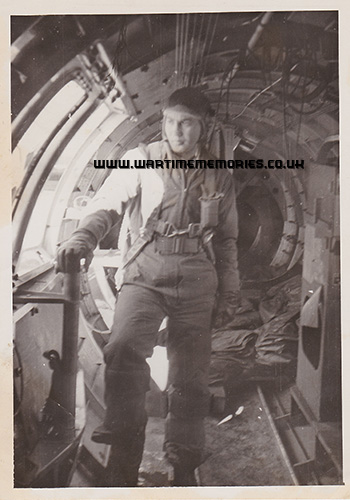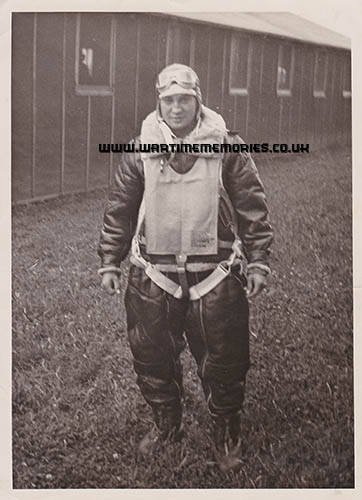|
|
|
|
|
The Wartime Memories Project is the original WW1 and WW2 commemoration website.
Announcements
- The Wartime Memories Project has been running for 24 years. If you would like to support us, a donation, no matter how small, would be much appreciated, annually we need to raise enough funds to pay for our web hosting and admin or this site will vanish from the web.
- 22nd April 2024 - Please note we currently have a huge backlog of submitted material, our volunteers are working through this as quickly as possible and all names, stories and photos will be added to the site. If you have already submitted a story to the site and your UID reference number is higher than 263973 your information is still in the queue, please do not resubmit, we are working through them as quickly as possible.
- Looking for help with Family History Research?
Please read our Family History FAQ's
- The free to access section of The Wartime Memories Project website is run by volunteers and funded by donations from our visitors. If the information here has been helpful or you have enjoyed reaching the stories please conside making a donation, no matter how small, would be much appreciated, annually we need to raise enough funds to pay for our web hosting or this site will vanish from the web.
If you enjoy this site
please consider making a donation.
Want to find out more about your relative's service? Want to know what life was like during the War? Our
Library contains an ever growing number diary entries, personal letters and other documents, most transcribed into plain text. |
|
We are now on Facebook. Like this page to receive our updates.
If you have a general question please post it on our Facebook page.
Wanted: Digital copies of Group photographs, Scrapbooks, Autograph books, photo albums, newspaper clippings, letters, postcards and ephemera relating to WW2. We would like to obtain digital copies of any documents or photographs relating to WW2 you may have at home. If you have any unwanted
photographs, documents or items from the First or Second World War, please do not destroy them.
The Wartime Memories Project will give them a good home and ensure that they are used for educational purposes. Please get in touch for the postal address, do not sent them to our PO Box as packages are not accepted.
World War 1 One ww1 wwII second 1939 1945 battalion
Did you know? We also have a section on The Great War. and a
Timecapsule to preserve stories from other conflicts for future generations.
|
|
Want to know more about Stalag Luft 4 Prisoner of War Camp? There are:22 items tagged Stalag Luft 4 Prisoner of War Camp available in our Library There are:22 items tagged Stalag Luft 4 Prisoner of War Camp available in our Library 
These include information on officers, regimental histories, letters, diary entries, personal accounts and information about actions during the Second World War. |
|
T/Sgt. Joseph Luke Burns 613th Bomb Squadron 401st Bomb Group My father served as a B-17 Flying Fortress flight engineer/top turret gunner during the war. On 1 December 1943, his bomber took part in a raid on Solingen in Germany's industrial Ruhr region. During the return flight, he and some crew-mates bailed out over Belgium after their bomber was hit by flak. For a short time, they were able to evade capture thanks to help given them by heroic members of the Belgian Resistance. Eventually, though, they were taken prisoner and spent the rest of the war in confinement.
|
Sgt. William Francis Brinley 338th Bomb Squadron 96th Bomb Group (H) William Brinley served with the US Air Force in WW2 flying with 96th Bomb Group.
Bill was a waist gunner on B-17G 42-102475. During a mission over Germany on 27th of May 1944, B-17 41-102561 collided with his aircraft.
Bill's B-17 broke in half at the radio room.
Three members of his crew were able to deploy their parachutes. These three were captured and Bill was sent to Stalag Luft IV. It is possible that he partook in the forced march across Germany when Russian forces were advancing in early 1945.
Bill ended up at Stalag 11B and was liberated by the British 7th Armoured Division.
|
Sgt. William Francis Brinley 338th Bomb Squadron 96th Bomb Group (H) Bill Brinley enlisted on 3rd of October 1942 in the USAAF.
After completing gunnery training, he was stationed at Snetterton, England with the 338th BS, 96th BG (H).
He was a waist gunner on the B-17G #42-102475. On 27th of May 1944, while flying in formation, another B-17 was attempting to avoid flack when the two planes collided.
Bill's B-17 split in two over Germany. He was able to exit the plane along with another crew member and deploy his parachute.
He was captured and eventually taken to Stalag Luft IV.
This is where he remained during the rest of the war.
|
Jack Bell 216 Squadron Jack Bell is an Australian who served in the RAF. He was shot down over North Africa. You can read is story in a book titled Jack Bell's War. In 2018 he is 100 years old as of writing.
Jack was a POW in Stalag Luft 4b
|
L/Sgt. Horace Daniel Morten 10th Btn. Royal Berkshire Regiment My Father, Horace Morten, enlisted in The Royal Berkshire Regiment on the 16th May 1940 aged 25, he trained at Reading and Calford before being posted to the Middle East Force and British North Africa Force.
He was captured in action in Italy in February 1944 and became a prisoner of war held at Stalag Luft IV in Germany for 14 months. During his time in captivity caught TB of the spine.
He was released and arrived in the UK in May 1945, following which he spent some time in hospital recovering from a major operation. He made a complete recovery and had a full and healthy life after the war, he died in 1991 aged 76.
|
Grover J. Loftin Grover Loftin was captured and was sent to Stalag Luft 4 - Tychow (formerly Heydekrug) Pomerania, Prussia (moved to Wobbelin Bei Ludwigslust) near Grosstychow, Prussia. He was held for 1 year and 1 month before being repatriated.
|
George Sidney Harper Advanced Landing Group 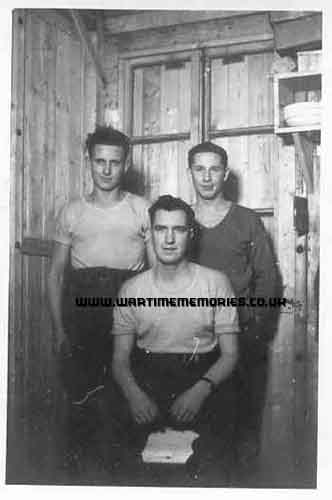 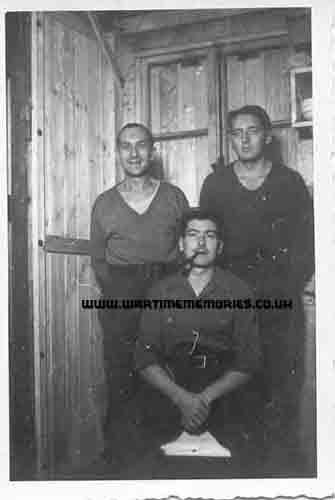 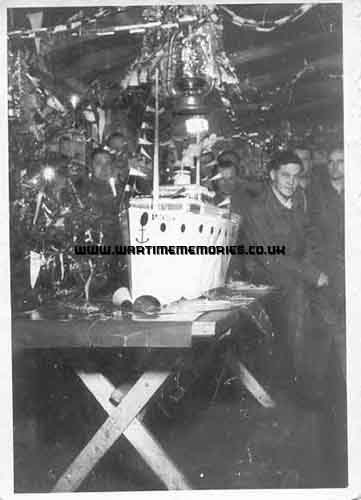 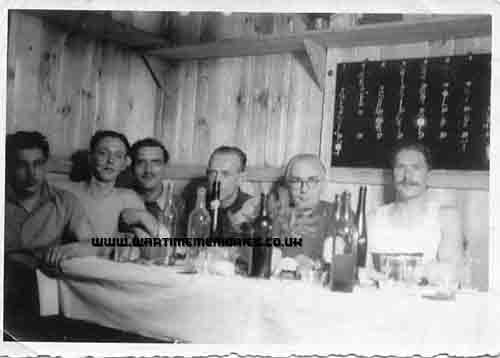 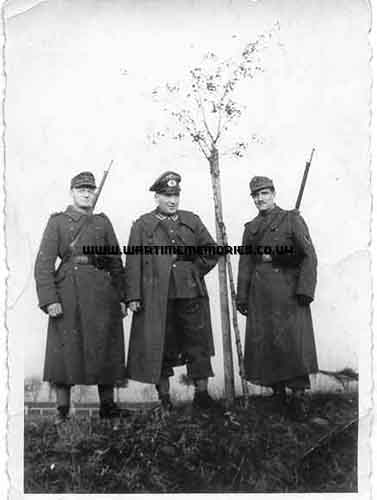 Intitially involved in training in the Hastings area, George Harper served in North Africa where the ALG team he was with rebuilt airfields captured from the opposition. He was a cook.
He then moved to the island of Cos where he was scalded by a tea urn knocked over by a bomb blast while the Germans were assaulting the island. He was scheduled to be flown out but another soldier handled a butterfly bomb and was more seriously hurt. Left in hospital when the island was over run, the German victors entered the hospital removing any Italians and shooting them.
George was heavily tanned after his trip across North Africa and was being grabbed to be removed and shot as an Italian. Fortunately one of the German officers spoke English and recognised him as a Tommy.
He was sent across the sea to Italy and then spent 20+ (28?) days in a cattle truck moving first to Stalag Luft IVB and then Chemnitz, IVF where he saw out the war. Part of the duties in Chemnitz was clearing rubble and bodies after bombing raids including reburying dead from a cemetery that was hit by a blast.
George (or me, his son) still has a dozen photos from IVF, many of prisoners and including a picture of and letter from the commandant.
|
Sgt. Cyril Patrick Cummings My Dad Cyril Cummings was a POW of WWII in Germany at Stalag Luft 4. He never talked about his experience there. We all knew it was too horrifying for him. Then the last year of his life he told me some horrific stories I will never forget.
These just tore my heart out as he spoke. Of course their food supply was little to nothing. A family, dad, mom and young son snuck food in for them when they could. The Germans caught the family and made the POW's watch them shoot all 3 of them to death.
Another time he talked about Christmas Eve. All the guys started to sing Silent Night and the Germans told them to stop but they didn't so the Germans started beating on them but they still wouldn't stop. They were beaten through the whole song but they did finish singing it completely.
I have spent several weeks on researching my dad's records and Stalag information but unfortunately not finding much. If by chance anyone reading this would recognize the names: Cyril Cummings, Bill Tate, Don Cairns, Forest Wilmouth and Charles O'Geen (as these were the men he was shot down with.) The name of the plane was San Antonio Rose, name of the crew was Oftenstein Crew, it would be a blessing to hear from you.
|
Tech/Sgt. Robert Floyd Stott My father, Robert Floyd Stott, was a tech/sgt on the big bombers over Germany during WWII. He was captured and interned in Stalag Luft 4 and Stalag Luft 6. I was very surprised to find out that he was also at Buchenwald for two weeks. His plane was called "Pegasus" and he was stationed in England.
|
Howard Ruble My uncle, Howard Ruble of Waynesville, Illinois was shot down over Berlin sometime in early 1944, I believe. He was taken to Stalag Luft 4, then was transferred to Luft 1 early in 1945. His camp was liberated by Russians in May 1945. Does anyone know anything about his POW experience?
|
Staff Sgt. H. Keith Mosley DFC  He enlisted in the Army Air Force in 1943.
Trained as an aerial gunner, Mr. Mosley flew 29 missions without incident on a B-24 Liberator out of England. On Nov. 26, 1944, during his 30th mission, just before he was to have rotated back to the United States, his entire squadron was shot down as it bombed the last German oil refineries at Misburg near Hannover.
He was locked in the top ball turret of the burning plane until pilot Wayne E. Stewart released him.
The aircraft exploded just as Mr. Mosley parachuted out. Five of the 10 men in the plane, including Stewart, were killed.
He was taken prisoner by the Germans. He spent 30 days in a room 8 by 10 feet in solitary confinement. He told of keeping his sanity by reciting poetry he had learned as a child and by calling imaginary baseball games featuring the Detroit Tigers.
At the end of December 1944, he and other prisoners were crammed into a cattle railroad car and taken to Stalag Luft Camp IV in Poland.
On Feb. 26, 1945, the prisoners began the "Death March Across Germany." Until the end of April, guards kept the starving prisoners on the move in snow and bitter cold, to delay their liberation by the advancing Soviet army, and later by the American and British armies.
The prisoners walked 800 miles across Poland and Germany, sleeping in barns and fields. They were given a quarter of a loaf of bread a week, so they subsisted by scrounging for food in garbage dumps.
He sold his sweater to a German housewife for a bowl of soup and exchanging his Army boots for a can of beef stew with a Sikh member of the British army.
In the final days of the march, he was so weak he fell behind his unit. But thoughts of home and his fiancee empowered him to catch up. On April 26, 1945, near Halle, Germany, an American jeep drove up while the men were resting by the side of a road and liberated them.
The men were taken to a temporary camp on the French coast before being shipped home. "How emotional was the moment, as we sailed into New York Harbor and glided past the Statue of Liberty," Mr. Mosley told his family.
The men were taken to a temporary camp on the French coast before being shipped home. "How emotional was the moment, as we sailed into New York Harbor and glided past the Statue of Liberty,"
He was honorably discharged from the Army Air Force in October 1945 with the rank of staff sergeant.
He was awarded the European-African-Middle Eastern Campaign Ribbon with four bronze stars, the Air Medal with four oak leaf clusters, and the Distinguished Flying Cross.
He died, aged 91, on 26th November 2015
http://www.philly.com/philly/news/20151218_H__Keith_Mosley__91__Temple_official__decorated_WWII_veteran.html#JUR6ARkoc8OPoVJF.99
|
Norman Wiseman 15th Airforce I was a B-24 engineer/gunner assigned to 15th Airforce and flew from Italy. I was shot down on 25 July 1944 at Lintz, Austria. I was sent to Stalag Luft 4. I made the 86 day march and was released on 2nd May 1945.
|
W/O. Raymond Thomas Marquet 75 Squadron My father, Ray Marquet, joined the RNZAF in 1940 aged 21.
He was trained as an observer (gun aimer) at Jervis 1 Bomber school
in Ontario Canada passing as a navigator on Ansons and later Wellington bombers. He flew 13 operations before being shot down over Benghazi on 3rd of April 1942.
He and all the crew bailed out safely with only the rear gunner Joe Galland spraining his ankle on impact with the Western Desert.
They were taken in by the local tribesmen who initially looked after them, but after a few days alerted the local German troops of their whereabouts (an entire Wellington bomber crew would have been a good prize.)
They were taken to Germany and housed at Dulag Luft where my dad (who was a jazz pianist in his spare time before the war) entertained the troops. He was actually kept there longer than was normal as he was judged to be good for morale.
He was later sent to Stalag Luft 4B where he stayed for 3 1/2 years until the war ended. He never really talked about this time, but when he was demobbed and sent home to NZ he weighed 6 stone (he was a strapping 6 footer before the war).
|
Jack LaCara Canicatti 719th Squadron 449th Bomber Group My Grandfather, Jack Canicatti of 449th Bomber Group 719th Squadron, took off from Grottaglie on 17th October, 1944. The target of mission 150 was to blow up the railways in Vienna, Austria. The B24 liberator named "Spirit of Plainfield, NJ" (s/n 42-51763) was hit and started losing altitude. My Grandfather, the left waist gunner was injured in his leg, as was the navigator John W. Clark. All 10 men managed to bail out before the plane crashed.
My Grandfather was taken to the hospital in Györ, Hungary where he remained for a month. He was then taken to Stalag Luft IV.
|
L/Cpl. Stanley George Jones 26th Canterbury Regiment My Grandad Stanley Jones, was captured at the El Mreir Depression July 22, 1942 (along with so many other New Zealanders). He told me that he was taking a piss when the Panzers rocked up. He didn't put his hands down as he was afraid they would shoot him. He ended up with frostbite on his bits.
He had seen service in Greece, Syria, Cyrenaica & Egypt.
He had been placed into an Italian POW camp (I'm trying discover which ones) and escaped for the first time on the Italian Armistance. He and a mate had made for the hills and been hidden by Partisans. He lived and worked as an Italian until being recaptured 12 months later and transported to Germany. They eventually gave themselves up (both were in a sorry state and had dysentry). I am not sure of the details of his second escape as he told me when I was a young boy.
On 8.9.1943 Escaped from POW camp Italy (Italian capitulation)
After being in several camps in Italy he made his escape at the time of the Italian capitulation in 1943. In 1944 he was recaptured and sent to
Lager 11a Alton Grabow, near Madgeburg (NCO camp) then Stalag 357 Fallingbostel, north of Hanover and then to Stalag XIII. He took part in the
Long march into Mechlenburg-Schwerin and was liberated at Salam-bi-Ratzburg
On the 23.12.1945 he returned to Christchurch, New Zealand on the Troopship Mooltan and was discharged on 10.5.1946.
|
T/Sgt. Joseph Luke Burns 613th Bomb Squadron 401st Bomb Group My father served as a B-17 Flying Fortress flight engineer/top turret gunner during the war. On 1 December 1943, his bomber took part in a raid on Solingen in Germany's industrial Ruhr region. During the return flight, he and some crew-mates bailed out over Belgium after their bomber was hit by flak. For a short time, they were able to evade capture thanks to help given them by heroic members of the Belgian Resistance. Eventually, though, they were taken prisoner and spent the rest of the war in confinement.
|
Sgt. William Francis Brinley 338th Bomb Squadron 96th Bomb Group (H) William Brinley served with the US Air Force in WW2 flying with 96th Bomb Group.
Bill was a waist gunner on B-17G 42-102475. During a mission over Germany on 27th of May 1944, B-17 41-102561 collided with his aircraft.
Bill's B-17 broke in half at the radio room.
Three members of his crew were able to deploy their parachutes. These three were captured and Bill was sent to Stalag Luft IV. It is possible that he partook in the forced march across Germany when Russian forces were advancing in early 1945.
Bill ended up at Stalag 11B and was liberated by the British 7th Armoured Division.
|
Sgt. William Francis Brinley 338th Bomb Squadron 96th Bomb Group (H) Bill Brinley enlisted on 3rd of October 1942 in the USAAF.
After completing gunnery training, he was stationed at Snetterton, England with the 338th BS, 96th BG (H).
He was a waist gunner on the B-17G #42-102475. On 27th of May 1944, while flying in formation, another B-17 was attempting to avoid flack when the two planes collided.
Bill's B-17 split in two over Germany. He was able to exit the plane along with another crew member and deploy his parachute.
He was captured and eventually taken to Stalag Luft IV.
This is where he remained during the rest of the war.
|
Jack Bell 216 Squadron Jack Bell is an Australian who served in the RAF. He was shot down over North Africa. You can read is story in a book titled Jack Bell's War. In 2018 he is 100 years old as of writing.
Jack was a POW in Stalag Luft 4b
|
L/Sgt. Horace Daniel Morten 10th Btn. Royal Berkshire Regiment My Father, Horace Morten, enlisted in The Royal Berkshire Regiment on the 16th May 1940 aged 25, he trained at Reading and Calford before being posted to the Middle East Force and British North Africa Force.
He was captured in action in Italy in February 1944 and became a prisoner of war held at Stalag Luft IV in Germany for 14 months. During his time in captivity caught TB of the spine.
He was released and arrived in the UK in May 1945, following which he spent some time in hospital recovering from a major operation. He made a complete recovery and had a full and healthy life after the war, he died in 1991 aged 76.
|
Grover J. Loftin Grover Loftin was captured and was sent to Stalag Luft 4 - Tychow (formerly Heydekrug) Pomerania, Prussia (moved to Wobbelin Bei Ludwigslust) near Grosstychow, Prussia. He was held for 1 year and 1 month before being repatriated.
|
George Sidney Harper Advanced Landing Group      Intitially involved in training in the Hastings area, George Harper served in North Africa where the ALG team he was with rebuilt airfields captured from the opposition. He was a cook.
He then moved to the island of Cos where he was scalded by a tea urn knocked over by a bomb blast while the Germans were assaulting the island. He was scheduled to be flown out but another soldier handled a butterfly bomb and was more seriously hurt. Left in hospital when the island was over run, the German victors entered the hospital removing any Italians and shooting them.
George was heavily tanned after his trip across North Africa and was being grabbed to be removed and shot as an Italian. Fortunately one of the German officers spoke English and recognised him as a Tommy.
He was sent across the sea to Italy and then spent 20+ (28?) days in a cattle truck moving first to Stalag Luft IVB and then Chemnitz, IVF where he saw out the war. Part of the duties in Chemnitz was clearing rubble and bodies after bombing raids including reburying dead from a cemetery that was hit by a blast.
George (or me, his son) still has a dozen photos from IVF, many of prisoners and including a picture of and letter from the commandant.
|
Sgt. Cyril Patrick Cummings My Dad Cyril Cummings was a POW of WWII in Germany at Stalag Luft 4. He never talked about his experience there. We all knew it was too horrifying for him. Then the last year of his life he told me some horrific stories I will never forget.
These just tore my heart out as he spoke. Of course their food supply was little to nothing. A family, dad, mom and young son snuck food in for them when they could. The Germans caught the family and made the POW's watch them shoot all 3 of them to death.
Another time he talked about Christmas Eve. All the guys started to sing Silent Night and the Germans told them to stop but they didn't so the Germans started beating on them but they still wouldn't stop. They were beaten through the whole song but they did finish singing it completely.
I have spent several weeks on researching my dad's records and Stalag information but unfortunately not finding much. If by chance anyone reading this would recognize the names: Cyril Cummings, Bill Tate, Don Cairns, Forest Wilmouth and Charles O'Geen (as these were the men he was shot down with.) The name of the plane was San Antonio Rose, name of the crew was Oftenstein Crew, it would be a blessing to hear from you.
|
Tech/Sgt. Robert Floyd Stott My father, Robert Floyd Stott, was a tech/sgt on the big bombers over Germany during WWII. He was captured and interned in Stalag Luft 4 and Stalag Luft 6. I was very surprised to find out that he was also at Buchenwald for two weeks. His plane was called "Pegasus" and he was stationed in England.
|
Howard Ruble My uncle, Howard Ruble of Waynesville, Illinois was shot down over Berlin sometime in early 1944, I believe. He was taken to Stalag Luft 4, then was transferred to Luft 1 early in 1945. His camp was liberated by Russians in May 1945. Does anyone know anything about his POW experience?
|
Staff Sgt. H. Keith Mosley DFC  He enlisted in the Army Air Force in 1943.
Trained as an aerial gunner, Mr. Mosley flew 29 missions without incident on a B-24 Liberator out of England. On Nov. 26, 1944, during his 30th mission, just before he was to have rotated back to the United States, his entire squadron was shot down as it bombed the last German oil refineries at Misburg near Hannover.
He was locked in the top ball turret of the burning plane until pilot Wayne E. Stewart released him.
The aircraft exploded just as Mr. Mosley parachuted out. Five of the 10 men in the plane, including Stewart, were killed.
He was taken prisoner by the Germans. He spent 30 days in a room 8 by 10 feet in solitary confinement. He told of keeping his sanity by reciting poetry he had learned as a child and by calling imaginary baseball games featuring the Detroit Tigers.
At the end of December 1944, he and other prisoners were crammed into a cattle railroad car and taken to Stalag Luft Camp IV in Poland.
On Feb. 26, 1945, the prisoners began the "Death March Across Germany." Until the end of April, guards kept the starving prisoners on the move in snow and bitter cold, to delay their liberation by the advancing Soviet army, and later by the American and British armies.
The prisoners walked 800 miles across Poland and Germany, sleeping in barns and fields. They were given a quarter of a loaf of bread a week, so they subsisted by scrounging for food in garbage dumps.
He sold his sweater to a German housewife for a bowl of soup and exchanging his Army boots for a can of beef stew with a Sikh member of the British army.
In the final days of the march, he was so weak he fell behind his unit. But thoughts of home and his fiancee empowered him to catch up. On April 26, 1945, near Halle, Germany, an American jeep drove up while the men were resting by the side of a road and liberated them.
The men were taken to a temporary camp on the French coast before being shipped home. "How emotional was the moment, as we sailed into New York Harbor and glided past the Statue of Liberty," Mr. Mosley told his family.
The men were taken to a temporary camp on the French coast before being shipped home. "How emotional was the moment, as we sailed into New York Harbor and glided past the Statue of Liberty,"
He was honorably discharged from the Army Air Force in October 1945 with the rank of staff sergeant.
He was awarded the European-African-Middle Eastern Campaign Ribbon with four bronze stars, the Air Medal with four oak leaf clusters, and the Distinguished Flying Cross.
He died, aged 91, on 26th November 2015
http://www.philly.com/philly/news/20151218_H__Keith_Mosley__91__Temple_official__decorated_WWII_veteran.html#JUR6ARkoc8OPoVJF.99
|
Norman Wiseman 15th Airforce I was a B-24 engineer/gunner assigned to 15th Airforce and flew from Italy. I was shot down on 25 July 1944 at Lintz, Austria. I was sent to Stalag Luft 4. I made the 86 day march and was released on 2nd May 1945.
|
W/O. Raymond Thomas Marquet 75 Squadron My father, Ray Marquet, joined the RNZAF in 1940 aged 21.
He was trained as an observer (gun aimer) at Jervis 1 Bomber school
in Ontario Canada passing as a navigator on Ansons and later Wellington bombers. He flew 13 operations before being shot down over Benghazi on 3rd of April 1942.
He and all the crew bailed out safely with only the rear gunner Joe Galland spraining his ankle on impact with the Western Desert.
They were taken in by the local tribesmen who initially looked after them, but after a few days alerted the local German troops of their whereabouts (an entire Wellington bomber crew would have been a good prize.)
They were taken to Germany and housed at Dulag Luft where my dad (who was a jazz pianist in his spare time before the war) entertained the troops. He was actually kept there longer than was normal as he was judged to be good for morale.
He was later sent to Stalag Luft 4B where he stayed for 3 1/2 years until the war ended. He never really talked about this time, but when he was demobbed and sent home to NZ he weighed 6 stone (he was a strapping 6 footer before the war).
|
Jack LaCara Canicatti 719th Squadron 449th Bomber Group My Grandfather, Jack Canicatti of 449th Bomber Group 719th Squadron, took off from Grottaglie on 17th October, 1944. The target of mission 150 was to blow up the railways in Vienna, Austria. The B24 liberator named "Spirit of Plainfield, NJ" (s/n 42-51763) was hit and started losing altitude. My Grandfather, the left waist gunner was injured in his leg, as was the navigator John W. Clark. All 10 men managed to bail out before the plane crashed.
My Grandfather was taken to the hospital in Györ, Hungary where he remained for a month. He was then taken to Stalag Luft IV.
|
L/Cpl. Stanley George Jones 26th Canterbury Regiment My Grandad Stanley Jones, was captured at the El Mreir Depression July 22, 1942 (along with so many other New Zealanders). He told me that he was taking a piss when the Panzers rocked up. He didn't put his hands down as he was afraid they would shoot him. He ended up with frostbite on his bits.
He had seen service in Greece, Syria, Cyrenaica & Egypt.
He had been placed into an Italian POW camp (I'm trying discover which ones) and escaped for the first time on the Italian Armistance. He and a mate had made for the hills and been hidden by Partisans. He lived and worked as an Italian until being recaptured 12 months later and transported to Germany. They eventually gave themselves up (both were in a sorry state and had dysentry). I am not sure of the details of his second escape as he told me when I was a young boy.
On 8.9.1943 Escaped from POW camp Italy (Italian capitulation)
After being in several camps in Italy he made his escape at the time of the Italian capitulation in 1943. In 1944 he was recaptured and sent to
Lager 11a Alton Grabow, near Madgeburg (NCO camp) then Stalag 357 Fallingbostel, north of Hanover and then to Stalag XIII. He took part in the
Long march into Mechlenburg-Schwerin and was liberated at Salam-bi-Ratzburg
On the 23.12.1945 he returned to Christchurch, New Zealand on the Troopship Mooltan and was discharged on 10.5.1946.
|
Recomended Reading.Available at discounted prices.
|
Footprints on the Sands of Time: RAF Bomber Command Prisoners of War in Germany 1939-45Oliver Clutton-Brock
he first part of this book deals with German PoW camps as they were opened, in chronological order and to which the Bomber Command PoWs were sent. Each chapter includes anecdotes and stories of the men in the camps - capture, escape, illness, murder and more - and illustrates the awfulness of captivity even in German hands. Roughly one in every 20 captured airmen never returned home. The first part of the book also covers subjects such as how the PoWs were repatriated during the war; how they returned at war's end; the RAF traitors; the war crimes; and the vital role of the Red Cross. The style is part reference, part narrative and aims to correct many historical inaccuracies. It also includes previously unpublished photographs. The second part comprises an annotated list of all 10,995 RAF Bomber Command airmen who were taken prisoner, together with an extended introduction. The book provides an important contribution to our knowledge of the war. It is a reference work not only for the
|
|
|




